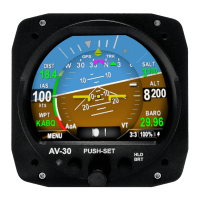What to do if uAvionix Avionics Display shows “NO AP” flag on startup?
- CCatherine NobleAug 25, 2025
If the uAvionix Avionics Display shows “NO AP” flag on startup, check the interface cables and pinout between AV-APA and AV-30-E.

What to do if uAvionix Avionics Display shows “NO AP” flag on startup?
If the uAvionix Avionics Display shows “NO AP” flag on startup, check the interface cables and pinout between AV-APA and AV-30-E.
| Brand | uAvionix |
|---|---|
| Model | AV-30-E |
| Category | Avionics Display |
| Language | English |
This installation manual applies to the AV-30-E (non-certified) and other product variants.
Provides definitions for acronyms and terms used throughout the AV-30-E installation manual.
Details the uAvionix AV-30 as a digital multi-mode instrument for aircraft cockpits.
Outlines the primary, supplemental, and audio/visual alerting functions of the AV-30 system.
Lists the design standards and MOPS the AV-30 satisfies for performance.
Shows typical six-pack instrument arrangement and AV-30 placement.
Explains how to set the AV-30's operating mode (AI, DG, MFD) during installation.
Details the electrical and pneumatic connections required for AV-30 system integration.
Tabulates features supported by the AV-30 in AI and DG modes and their required interfaces.
Describes the optional connection for an Outside Air Temperature (OAT) probe.
Details the optional audio panel connection for low-voltage analog output.
Covers the optional RS-232 serial interface for connecting GPS units or AV-HSI.
Describes the optional internal magnetometer and its calibration requirements.
Details the optional AV-Mag external magnetometer, its sensitivity, and calibration needs.
Explains how the AV-30 can control uAvionix transponders like BeaconX.
Covers the AV-Link accessory for traffic display via Wi-Fi with ADS-B receivers.
Details AV-30's capability to control analog and digital autopilots, often via AV-APA.
Explains the AV-30's internal battery, its capacity, and behavior during power loss.
Outlines the general steps involved in installing the AV-30 unit and related components.
Lists the components included in the AV-30-E Installation Kit and the AV-30-E units.
Lists components that are not supplied with the AV-30-E installation kit but are required.
Specifies what information needs to be recorded in the aircraft's logbook after installation.
Provides dimensional drawings of the AV-30 unit for installation planning.
Details the procedure for physically mounting the AV-30 unit to the aircraft instrument panel.
Explains how wiring varies based on installation configuration and refers to figures for diagrams.
Details the grounding requirements for electrical connections, including shield and strap use.
Provides a table detailing the function of each pin on the AV-30 connector.
Details the AV-Link accessory for traffic display, firmware updates, and connectivity.
Introduces the tailBeaconX transponder and its integration with the AV-30.
Details the AV-Mag external magnetometer for heading measurement and installation.
Introduces the AV-APA for emulating analog heading signals for legacy autopilots.
Details operation and control of AeroCruze/TruTrak and Trio Pro Pilot autopilots with the AV-30.
Introduces the AV-HSI for course and glideslope guidance, and its role as a hub for navigation data.
Explains AV-30's role as a backup to EFIS and user variable synchronization.
Describes the initial splash screen and common user interface controls for AI and DG modes.
Categorizes menus into Edit Fields, Setup, and Install menus for configuration and setup.
Covers essential settings required for every AV-30 installation, like Unit Function and Function Lock.
Details procedures for system checkout before returning the aircraft to service.